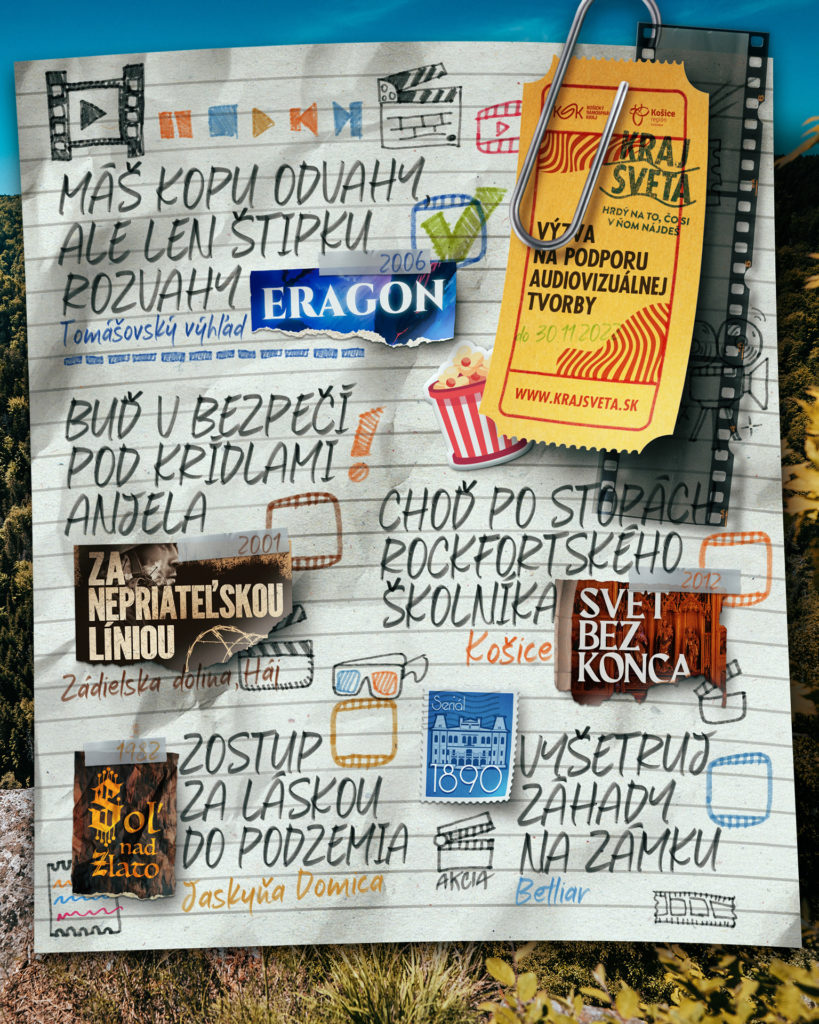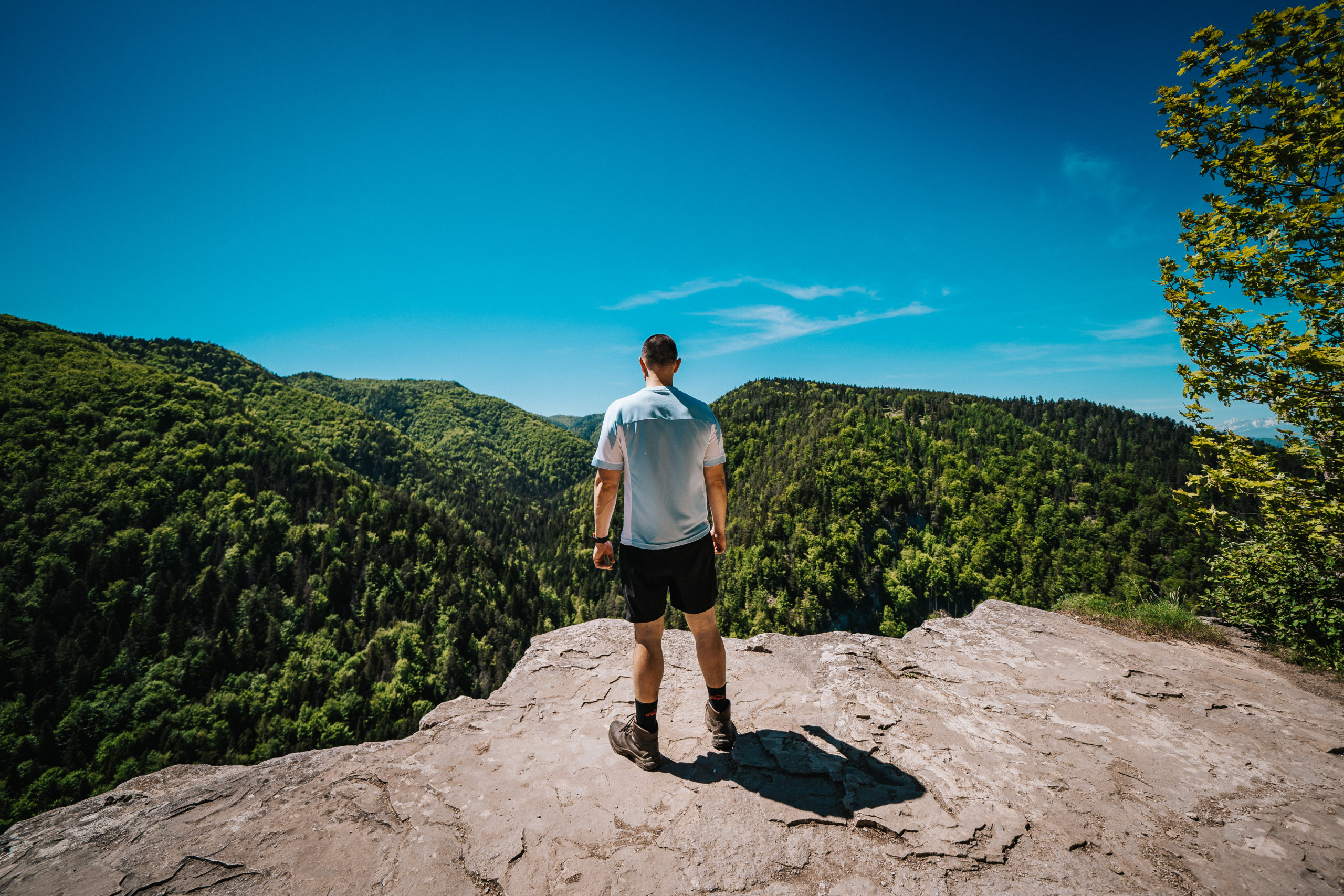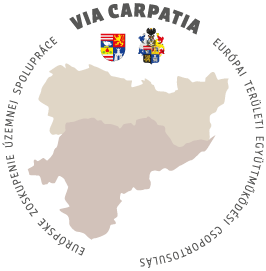1. You’ve got heaps of courage, but only a pinch of discretion.
Eragon 2006, Tomášovský výhľad view
Can you even imagine that? You being the writer of a loose sequel to the film Eragon? One excellent scene of it was shot in the Slovak Paradise at the Tomášovský Výhľad view, so feel free, you have the courage to do it, throw away your discretion and head out to immortalise the view as a director or a screenwriter. What if the regional audiovisual industry is waiting just for you? After all, the main character Eragon wasn’t even played by a famous Hollywood hunk, but by an ordinary Edward Speleers. An eighteen-year-old English debutant who beat out a whopping 180 thousand other hopefuls for the role in an audition! And that’s a challenge for you, don’t wait for your higher age, take to the heights of the Tomášovský Výhľad view, where the prospect of your cinematic future is waiting for you.
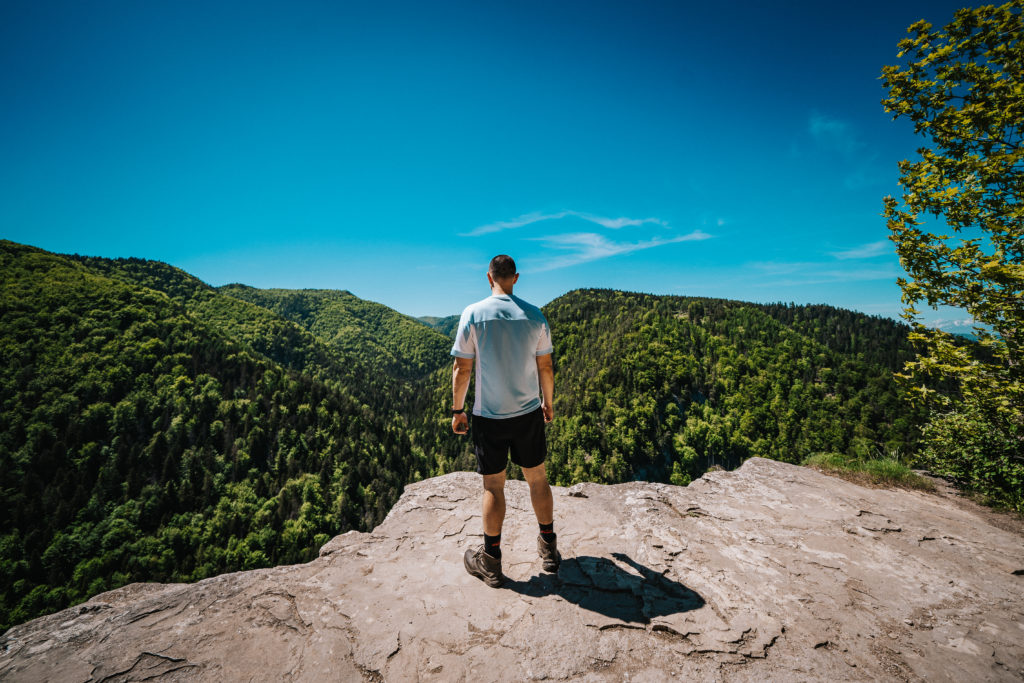
From the Tomášovský Výhľad view, we have a view of the Čertova Diera (Devil’s Hole), which is also worthy for the dragoness Saphira to step into it and for the story to be played out anew in a paradisiacal setting. After all, Saphira is certainly not the first dragon to ever have visited Slovakia, she may have seen the Tatra Mountains, but her longing for the Paradise has remained in her! So sit down on the tempting cliff edge of the Tomášovský Výhľad view, see the Tatra Mountains in their full grandeur from there, and jump into the film world with your story in its sequel. After all, the appearance of real dragons, spouting fire and smashing rocks, has so far been documented only indirectly, in folklore. Change that. The geographical names of Dračí Štít, Dračie Pleso, Vyšné Dračie Sedlo, Dračie Pazúriky, Dračia Hlava, Dračia Dolinka, etc. are all linked to the legend of a terrifying dragon that tormented the inhabitants of the villages of the Tatra foothills for so long that it fossilized in the upper part of the Zlomisková Dolina valley. We may learn more about dragons, this time from the height of the Tomášovský Výhľad view, in your sequel to Eragon. So do not wait and start writing another script.
Jeremy Irons as Brom, John Malkovich as King Galbatorix and the spectacular Eragon adventure is based on the worldwide bestselling book from the pen of Christopher Paolini, an American aged just 22. The fate of a young man, played by Edward Speleers, changes the moment he learns he is part of the elite Dragon Riders. The protagonist, Eragon, is drawn into a world of magic and power, discovering that he can save – or, conversely, destroy – the entire Empire.
2. Descending to the underground in search of love.
The Salt Princess 1982, Jaskyňa Domica cave
Princess love is every Marushka’s dream, so take some of that magical cave power with a pinch of living salt. Descend to the mysterious beauty of the underground and peek out of the caverns of all groups and beautiful structures in the longest cave of the Karst. And then your experience will turn into a golden and dazzling glow of love. The cave is also characterised by cascading pools full of eternal love, bulbous stalactites and pagoda-like stalagmites created from the living “tears” shed from the romantic devotion of the Marushes of all ages. Melt with love the stalagmite sculpture of the Prince of Salt.
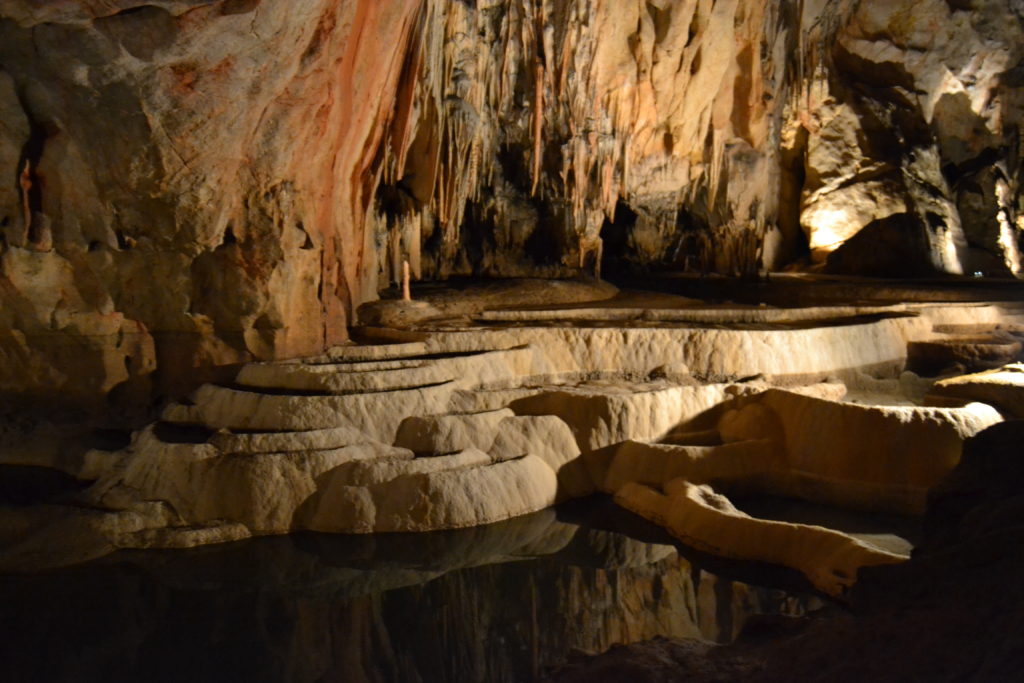
The story of the film The Salt Princess begins here with a tournament where knights fight for the favour of Vanda, Barbara, and Marushka, daughters of King Pravoslav. While the lovers of Vanda and Barbora successfully defeat their rivals, Marushka escapes to the garden where she meets her admirer. The handsome and mysterious prince is in fact the son of the King of the Underworld. King Pravoslav wants to bestow his crown on the daughter who expresses her love for him most warmly. While Vanda and Barbora talk about gold and jewels, Marushka declares that she loves her father like salt, which she thinks is more valuable than gold. Offended, the King scorns the salt, banishes Marushka from the castle, and rudely humiliates the Prince of Salt. At that moment the King of the Underworld appears and curses the Kingdom of Pravoslav. All the salt turns to gold, but the initial joy does not last long. Now it is Marushka’s task not only to save her father’s kingdom, but also the Prince of Salt, turned into a statue.
Domica is the most famous and longest cave in the Slovak Karst National Park. The discovery of the cave dates back to 1926 and it has been open since 1932. Since 1995, it has been a UNESCO World Natural Heritage Site. It attracts attention especially by its rare archaeological findings, abundant occurrence of sinter shields and drums, as well as numerous species of bats. The cave is connected to the Čertova Diera (Devil’s Hole) Cave and forms a single unit with the Baradla Cave in the Republic of Hungary, with a total length of about 25 km. Domica Cave is 5,368 m long and 70 m deep. Its rarity is that in times of abundant water in the underground river Styx, a tour of the cave is combined with boating. The short circuit is 780 m long; the long circuit (without boating) is 1180 m long, the circuit with boating is 930 m long, of which the boating is 150 m long. The duration of the short circuit tour is about 45 min, for the long circuit and the circuit with cruise it is about 60 min. The temperature in the cave ranges from 10.2 to 11.4°C. Majkov Dome with its cascading waterfalls, also known as the Roman Baths, is the most impressive underground chamber. In addition, the cave is also an important archaeological site, because prehistoric man lived there 5-6 thousand years ago in the younger Stone Age – Neolithic. Various stone and bone items were found during the excavations, some of which can be viewed in the entrance hall.
3. Walking in the footsteps of the Rockfort school janitor
The World Without End, 2012, Košice
Step into the territory of the majestic history of an even more majestic cathedral and follow the traces of a world without end between the pillars of a Gothic structure, and the equally cinematic time of the Black Death in the shadow of the pillars of the earth. There is no end to the exploration of St. Elizabeth’s Cathedral itself. So many unique sights under one and so unique a roof! Because the world of Košice is infinite. Just like the beginning of the Hundred Years’ War in the World Without End series, you too can spend a hundred years on St. Elizabeth’s Cathedral.
In the mid-14th century, England finds itself on the verge of the Hundred Years’ War, but at the same time, the horror of the Black Death is looming. But the plague epidemic that claimed thousands of lives also indirectly caused fundamental transformations in contemporary society that set the stage for the Renaissance. The narrative is once again set in that contemporaneous framework, where the fates, loves, and cruel plots of characters from all strata of the contemporaneous society intersect – from peasants and craftsmen to representatives of the church, noblemen and kings.
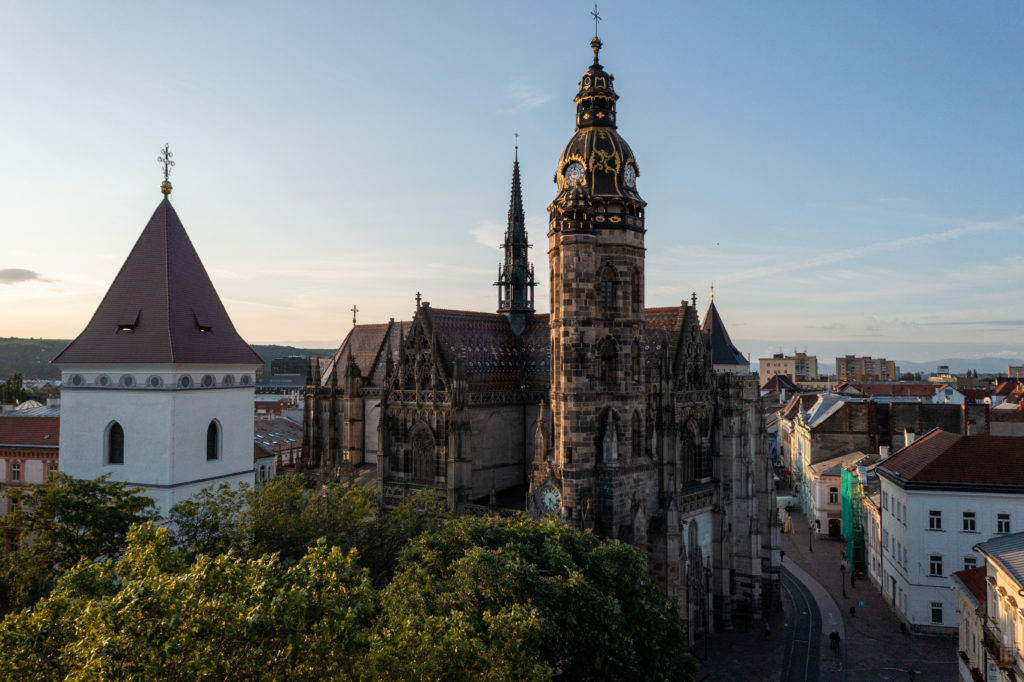
And this is where the first traces of the construction of St. Elizabeth’s Cathedral began. Its northern side boasts the most beautiful and ornate decoration. But! Except that the north side was seen as the side of evil. The sun did not shine on it, it was lashed by rain, it was cold. Many times, churches on this side had neither entrance nor windows. And here we suddenly have the complete opposite. Why? We don’t know. Try to find out. There are many challenges awaiting you here. From the end of the Hundred Years’ War to the end of the World War I – the all-metal neo-Gothic altar of the Holy Cross dedicated to the memory of the victims of the World War I. The construction was cast from weapons preserved on the battlefields of eastern Slovakia.
Five days of filming also took place in St. Elizabeth’s Cathedral in Košice, leaning on the pillars of beauty, history. St. Elizabeth’s Cathedral is indeed the largest church in Slovakia, the easternmost Gothic cathedral in Europe. With its length and height of 60 metres, it dominates the Main Street in Košice. It is simply unmissable. Uncompromising in its Gothic ornamentation, studded with statues, roses, gargoyles, mighty in its stone blocks, piercing in the prickly shapes of its door and window frames, ascetic in the slenderness of its ribs, columns, beams, colourful in its stained-glass windows. The royal staircase in the Cathedral is of a type that can only be found in Graz, Austria. Yes, there are probably only two double spiral Gothic staircases in Europe. Other staircases of a similar type are younger and date back to the Renaissance. The temple is full of European rarities. The main altar of the Cathedral is the only one in Central Europe that has two pairs of opening wings. It has not moved since it was built, and visitors can see twelve of its 48 paintings. All of them depict scenes from the life of St. Elizabeth of Thuringia. St. Elizabeth’s Cathedral is an amazing building. Its beauty, monumentality, and artistic rendering would certainly not put the Mecca of world Gothic in France to shame. That is why the Dome in Košice is a must-see!
4. Investigating mysteries at the castle.
1890 series, Betliar
Was the shadow of crime really hovering over Betliar? Suspense, drama, romance, and humour in the attractive setting of the Betliar Castle is what unlocks the castle into a mysterious mansion. Upon arrival, walk through the historic park where the manor house of the noble Andrássy family, which acquired its present character after its reconstruction in 1880-1886, stretches out. And it is in that period that the plot of the 13-part historical drama series entitled 1890 is set. It is set in a period when folk superstitions and beliefs in magic or supernatural beings mix with the advent of groundbreaking technical inventions such as the telephone or the automobile and the discovery of forensic methods and procedures still used today – dactyloscopy and ballistics. Throughout the series, horrifying superstitions circulate on young women – apart from Eržika, there were a few more – are being killed by a demon from the nearby Zádielská Tiesňava gorge. This theory is believed by almost everyone except Detective Marton, a progressive man.
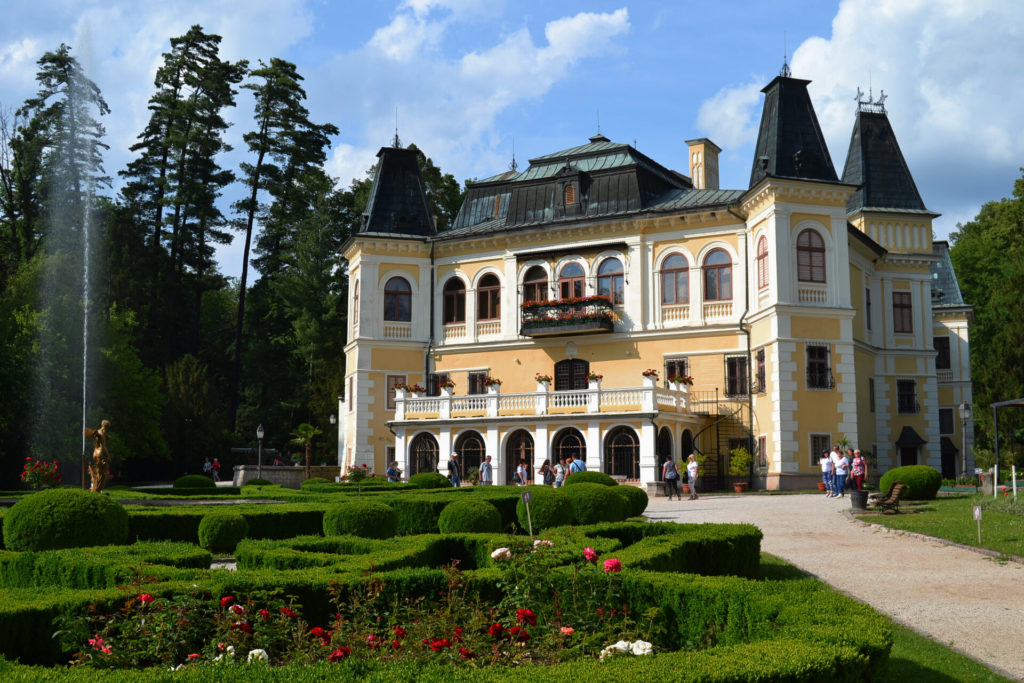
What do you believe? Explore the corners with a criminal plot, but in addition to suspense and surprising twists, there are also adventurous, romantic. and humorous elements. This is not a faithful period reconstruction and the creators, despite consulting experts, have not strived for absolute historical accuracy in all its components, but have created a world of their own. The main character of the series is the detective János Marton from Pest, played by Ján Koleník. János has an acknowledged eventful life, in which he brings out something for which he is punished. He must go to Betliar, where he will investigate a very complicated case that happened in a family. Marton’s story, however, is not just about investigating the case, but also about how he willy-nilly shuffles the cards in a wealthy family. So, the detective will not only uncover the background of the crime, but also the inner workings of the family, and in the meantime will search for the murderer.
The portraits of former prominent noblemen, their wives and family members hanging on the walls evoke natural respect. In a moment you realise how strikingly similar the series Count Wisniewski (Łukasz Kos) resembles the real Gejza Andrássy, who a hundred years ago loved to spend his summers here with his family and friends. Thus, under the skilful hands of make-up artists and costume designers, the serial actors transformed themselves into the Andrássy family, at least for a while, and brought us back to the thrilling past. The Red Drawing Room, where the serial count receives precious visitors, will not escape your attention. A century ago, the real-life nobleman Emanuel Andrássy, nicknamed the Iron Count because of his entrepreneurial activities in mining and metallurgy, similarly “officiated” here. The Andrássy family were important collectors and supporters of art, passionate travellers, and hunters, but they were also involved in politics and philanthropy. Gejza, Emanuel’s son, was also a distinguished traveller, successful businessman, politician, sportsman, and hunter, as well as a connoisseur of life and women. In Hungary, he domesticated previously unknown sports such as equestrian polo, golf, and yachting, but he also devoted himself to amateur photography and art.
Most of the serial scenes also take place in the dining room where the aristocracy used to meet. Dinners at the Andrássy’s sometimes lasted as long as five hours, as twenty courses were served. The dining room is one of more than 50 living rooms that the manor offers, not counting the 16 lavish bathrooms, of which the Andrássy family would not be ashamed even today. At the turn of the 19th and 20th centuries, the nobility enjoyed luxuries such as central heating, electric fuses, taps with hot and cold water, flush toilets and bidets, and a telephone. See the spiral staircase where the servants used to walk, the library, as well as the boiler room and the secret passage through which Detective Marton used to pass. Get in on the action and plant your free acting into it and allow the series to continue.
5. Staying safe under the wings of an angel
Behind Enemy Lines 2001, Zádielska Dolina gorge, Háj
You may encounter various curiosities while wandering around eastern Slovakia. One of them is the statue of an angel in the village of Háj. Therefore, take flight on the wings of an angel to the heights of Owen Wilson’s film fame and let yourself be enchanted by the picturesque Zádielska Dolina valley, which was also irresistible for director John Moore and his film Behind Enemy Lines (2001). In addition to Owen Wilson, the main roles were played by Gene Hackman, David Keith, Marko Igonda, and quite a few other American, Russian, and Slovak extras and minor roles.
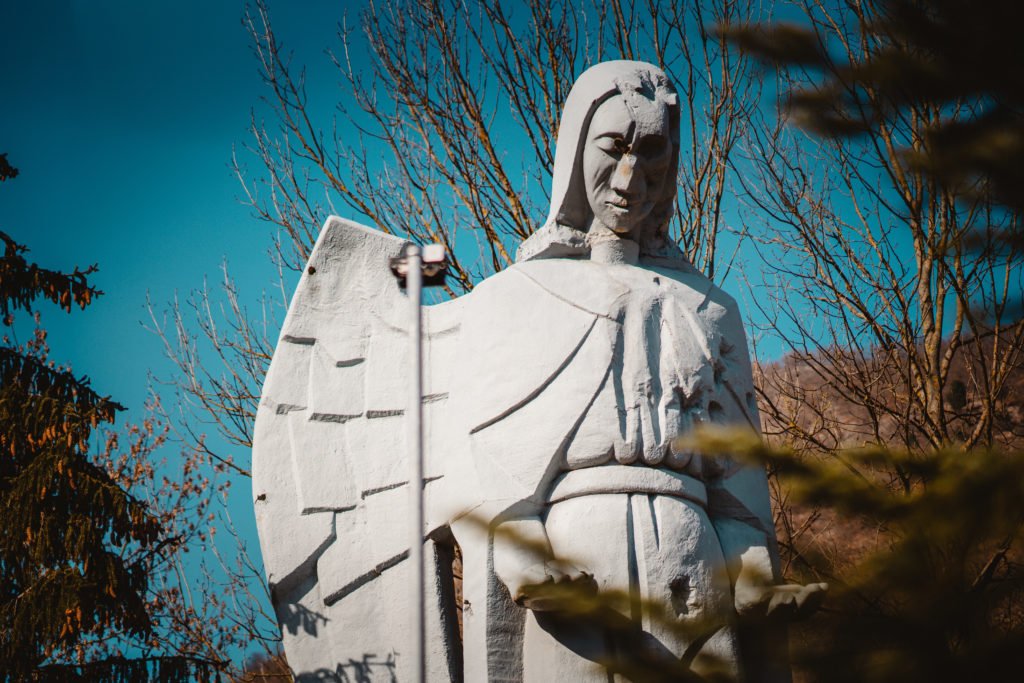
The Zádielska DOlina valley is the most important place associated with the film and its key scenes. The unforgettable scene of the frozen lake covered in ice, by which the sad statue of the gunned-down angel leans, was filmed in a natural exterior where there is in fact no lake. The film’s illusion of smooth plates on a wooden structure managed to evoke this impression truly beautifully. The sculpture, several metres high and without a single wing, is in fact made of modified polystyrene, and it has deliberately not had a wing since its manufacture. However, the unique work of art did not go to the “scrapheap”, but the filmmakers donated it to the village of Háj as a gift. This relieved them of the disposal duties and gave the municipality an artefact of special value to a film fan. As a film original, it is unique. The village, interesting by its name, is a year-round destination for film tourists who make their way here via the southern route between the west and the east, also to see the angel. It’s in a place where its bright colour and height stand out. It can be seen from many edges of the village. The information boards will tell you all the essentials. For example, in keeping with the theme of the action movie, the angel looks like someone shot part of his face and half of his body with a machine gun. A broken wing is lying on the ground next to him.
Set in war-torn Yugoslavia, the story of the film Behind Enemy Lines chronicles the events of the random uncovering of a mass grave by an F-18 reconnaissance fighter. The Serbian military, interested in ensuring that the photographed evidence of genocide does not reach NATO forces, fires an anti-aircraft missile towards the reconnaissance aircraft. The pilot and navigator manage to eject but find themselves with evidence of war crimes behind enemy lines. Soldiers search the wreckage, execute the navigator, while the pilot (Owen Wilson) manages to escape.
His fight for his own life and the harrowing journey to salvage the evidence begins. War-torn Yugoslavia, the real one, was not a matter of distant history. Some people we can meet in Slovakia – many foreign Slovaks from Vojvodina – experienced it for real. Their view of the film might be different. For the world and Slovak viewers, however, the illusion of Yugoslavia is so perfectly made that you really feel transported to a troubled, uncertain, and dangerous area. So, escape from the world of restlessness, stress and hecticness to the angelically beautiful nature with the idyllic waterfalls of Háj, to a safe zone under the protection of angelic wings.
